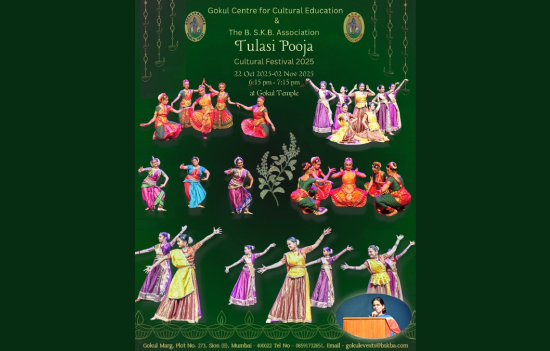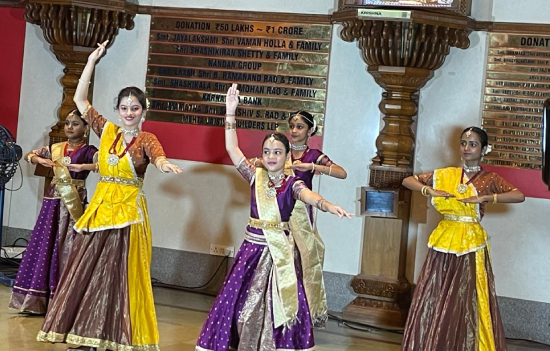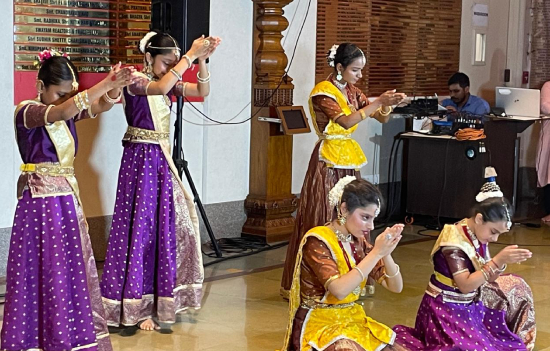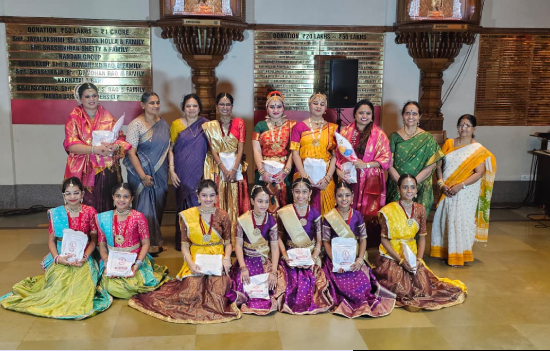- This photo feature covers various classical dance performances at Mumbai’s Gokul Mandir on the occasion of Tulasi Pooja.
This piece written by Moukthika Mistry, a budding
Kathak dancer of Ved Institute of Performing Arts.
Festival Details
Venue: Gokul Temple. Organized by: Gokul Centre for Culture Education & The B.S.K.B. Association. Date: 22nd October to 2nd November 2025
A vibrant celebration of devotion, tradition,
and community spirit.
This ten‑day festival, held at the serene premises of Gokul Temple, brings together devotees and cultural enthusiasts to honour Goddess Tulasi, symbolising purity, devotion, and prosperity. The celebrations included daily pooja rituals, bhajans, and a variety of cultural programmes showcasing classical music, dance, drama, and art performances by talented participants.
“In Sanatani tradition, Tulasi Pooja is deeply revered, with the Tulasi plant embodying Goddess Tulasi, representing purity, devotion, and spiritual growth. Worshipping Tulasi is believed to bring prosperity, ward off negativity, and deepen one’s divine connection. The festival’s daily rituals – offering water, lighting lamps, and devotional singing – create a peaceful atmosphere that fosters mindfulness, devotion, and community unity, while honouring the sacred plant.”
The event serves as a beautiful blend of spiritual enrichment and cultural expression, fostering unity and cultural awareness among all age‑groups.
As part of the Tulasi Pooja and Cultural Festival 2025, I had the wonderful opportunity to perform on 29th October 2025 with my group from the Ved Institute of Performing Arts, under the guidance of our respected Guru Smt. Aditi Yadav Ma’am. Our group presented a Ganesh Vandana based on Teentaal Taal, invoking Lord Ganesha’s blessings for the success of the event.
We were encouraged and supported by Madhu Didi, whose guidance helped us perfect every movement and expression. Performing in the divine atmosphere of Gokul Temple was a truly spiritual and joyful experience – the audience appreciated our coordination and devotion‑filled presentation.
In addition to our performance, the festival also featured a Bharatanatyam dance presented by the Nrityangan Dance Academy under the able guidance of Guru Divya Dave, and an Odissi dance performance by Guru Aditi Mirvankar Thomas. These performances added elegance and classical depth to the cultural evening.
The performances associated with us included a Shiv Dance by another talented group, full of energy and power, and a solo performance based on the epic Mahabharata, which was absolutely mesmerising and left a lasting impression on everyone present.
One of the highlights of the festival was the performance of "Chandrachooda Shivashankara Parvati" which beautifully depicted the cosmic energy shared between Lord Shiva and Goddess Parvati. The song highlighted how Shiv ji resides within himself and Parvati ji fills him with love and affection, making them a complete and perfect union.
This was followed by a mesmerizing depiction of Krishna's Leelas and the soulful rendition of the song "Krishna Radha" by Padma Vibhushan Pandit Biraju Maharaj ji.
The Odissi performance by Guru Aditi Mirvankar Thomas was another highlight, where she beautifully portrayed Draupadi's emotions. The festival concluded with a soulful rendition of Mira bhajans, including "Jaya jaya jaga jananI devi" and the recitation of Mahalakshmi Ashtostotra by the Bharata Natya Mali.
Participating in this cultural festival was an
inspiring experience that deepened my love for classical dance and our rich
cultural traditions. I feel proud and blessed to have been a part of this
wonderful celebration.

About the Temple
The Gokul Temple (Sri Krishna Mandir at Gokul Marg, Sion (East) is managed by the B.S.K.B. Association (also known as ‘Gokul’), a cultural‑social institution with over ninety years of history and more than four thousand life‑members.
The temple was constructed in the late 1950s
and early 1960s, with the foundation stone laid in 1956 and the inauguration of
the mandir taking place on 12/3/1962.
The sanctum houses the adorable deity of Lord Gopalakrishna — depicted playing the flute, with the figure of Gomata behind him — which devotees believe grants solace and fulfilment of wishes.
Daily rituals (Nitya Pooja) are conducted at precisely 7.30 a.m. and 7.30 p.m., including Kalasha Abhishekha, archana, deepa and arati, followed by distribution of prasada.
In recent years the temple has undergone renovation, with its marble murtis and fine wood‑carvings and architectural enhancements—bringing in a fresh elegance while preserving the tradition. The Times of India
The temple stands not only as a place of
worship but also as a cultural hub where festivals, bhajans, and community
activities unite generations under one roof and deepen our cultural roots.
We now feature pictures –
 Gokul Temple.
Gokul Temple.
 Performance clip
Performance clip
 Performance clip.
Performance clip.
 Performance clip.
Performance clip.
 Group photo.
Group photo.
To read all articles by Ved Institute of Performing Arts
To read all articles on Indian Dance Forms